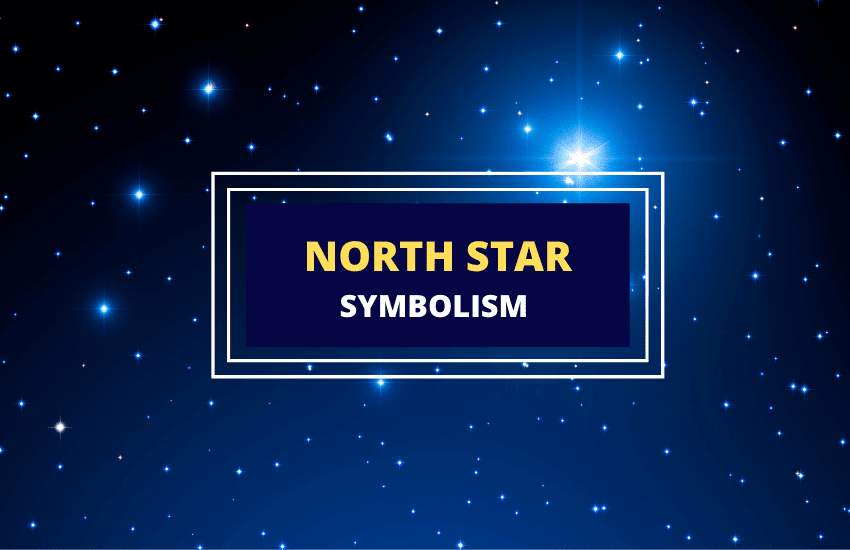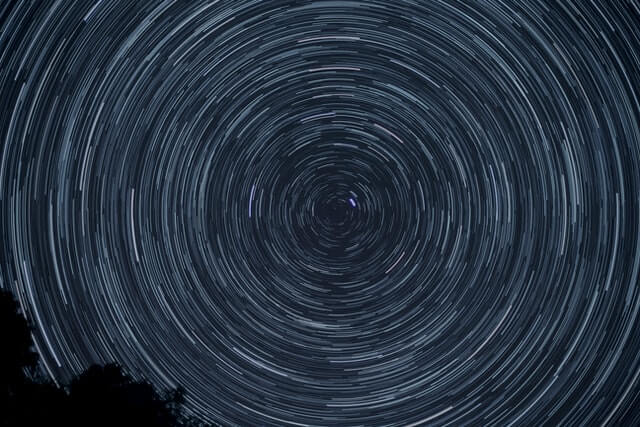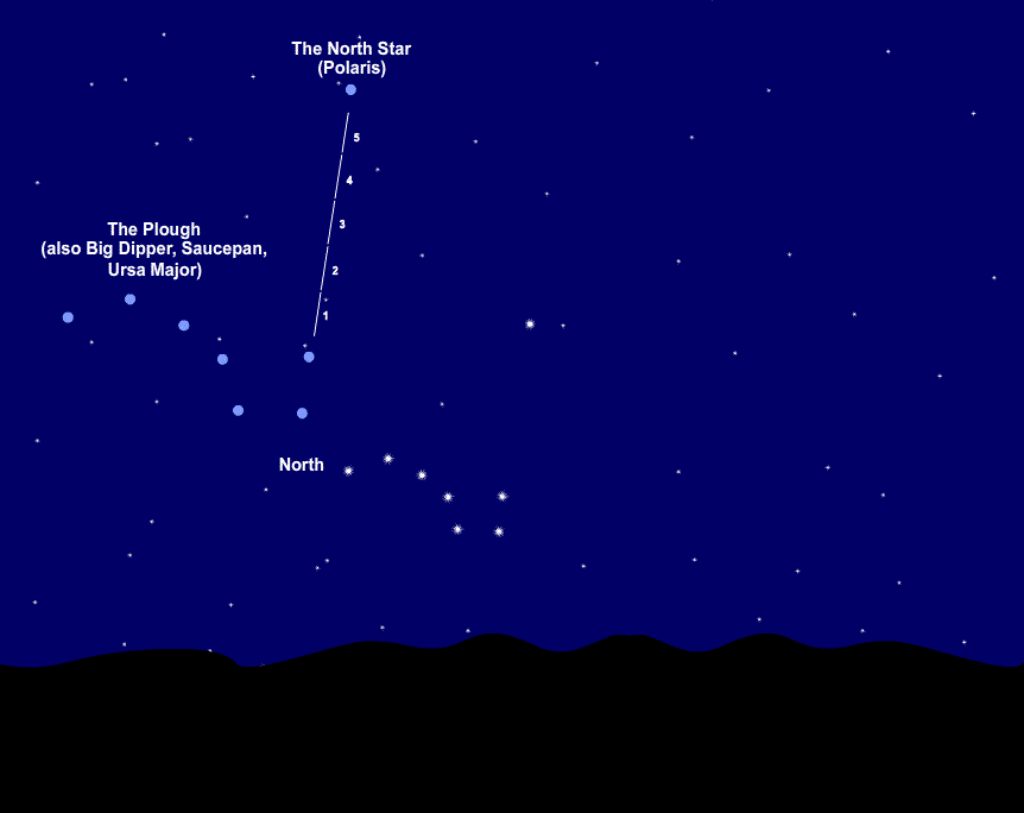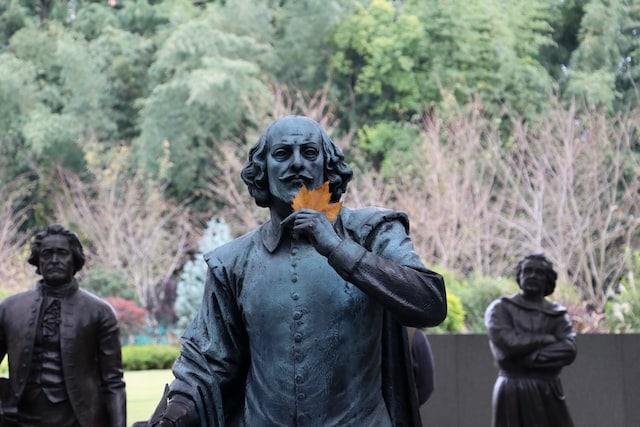
Table of Contents
For thousands of years, the North Star has been a guiding light for navigators and travelers, letting them sail the seas and cross the wilderness without getting lost. Formally known as Polaris, our North Star has served as a beacon of hope and inspiration for many. Let’s take a look at the North Star meaning and how it’s viewed in other cultures.
What Is the North Star?
The North Star always points to the north, just like a landmark or sky marker that helps in determining direction. When facing the North Star, the east would be on your right, the west on your left, and the south at your back.
At present, Polaris is regarded as our North Star, and sometimes goes by the name Stella Polaris, Lodestar, or Pole Star. Contrary to popular belief, it isn’t the brightest star in the night sky, and only ranks 48 on the list of brightest stars.
You can find the North Star at any time of the year, and at any hour of the night in the northern hemisphere. If you were to stand at the North Pole, you would see Polaris directly overhead. However, it drops below the horizon once you travel south of the equator.
Why Does the North Star Always Point North?
The North Star is called that because its location is almost exactly above the North Pole. In astronomy, this point in space is called the north celestial pole, which also aligns with the Earth’s axis. As the Earth spins on its axis, all stars seem to circle around this point, while the North Star appears fixed.
Think of it like spinning a basketball on your finger. The point where your finger touches stays at the same place, just like the North Star, but the points that are far from the axis of rotation seems to revolve around it. Unfortunately, there isn’t a star in the south-facing end of the axis, so there’s no South Star.
The Meaning and Symbolism of the North Star

People have watched the North Star for centuries and even depended on it to guide them. Since it’s the perfect combination of magical and mysterious, it soon gained various interpretations and meanings. Here are some of them:
1. Guidance and Direction
If you’re in the northern hemisphere, you can figure out your direction by finding the North Star. For thousands of years, it has been a handy survival tool for navigators and travelers, even in the darkest of nights. In fact, it’s more accurate than a compass, providing direction and helping people to stay on their course. Even today, knowing how to find the North Star remains one of the most basic survival skills.
2. Life’s Purpose and Passion
Ancient navigators observed that all the stars in the sky seem to circle around the North Star, which was known to ancient Greeks as Kynosoura, meaning dog’s tail. In the mid-16th century, the term was used for the North Star and the Little Dipper. By the 17th century, the North Star was used figuratively for anything that was the focus of attention.
Due to this, the North Star also became associated with life’s purpose, heart’s true desires, and unchangeable ideals to follow in your life. Just like the literal North Star, it gives you direction in life. As we look within ourselves, we can discover and develop the gifts that we already have, letting us achieve our full potential.
3. Constancy or Inconstancy
The North Star seems to be the center of the star field, associating it with constancy. Even though it does move a little in the night sky, it has been used as a metaphor for constancy in several poems and song lyrics. In Shakespeare’s Julius Caesar, the title character states, “But I am constant as the Northern Star, of whose true fixed and resting quality there is no fellow in the firmament”.
However, modern discoveries reveal that the North Star isn’t as constant as it seems, so it can sometimes represent the opposite. In modern astronomical terms, Caesar was basically saying that he was an unstable person.
4. Freedom, Inspiration, and Hope
During the period of slavery in the United States, enslaved African Americans struggled to gain their freedom, and relied on the North Star to escape to the northern states and Canada. Most slaves didn’t have compasses or maps, but the North Star gave them hope and freedom, by showing them the starting point and continuous connections on their journey northward.
5. Good Luck
Since seeing the North Star meant sailors were on their way home, it also became a symbol of good luck. In fact, the North Star is common in tattoos, especially for seafarers, in hopes of keeping luck with them all the time.
How to Find the North Star

Polaris belongs to the constellation of Ursa Minor, which consists of stars that make up the Little Dipper. It marks the end of the handle of the Little Dipper, whose stars are much fainter compared to those of the Big Dipper.
The Little Dipper is hard to find in a bright sky, so people find Polaris by looking for the pointer stars of the Big Dipper, the Dubhe and Merak. They’re called pointer stars because they always point to the North Star. These two stars trace the outer part of the Big Dipper’s bowl.

Simply imagine a straight line that extends about five times beyond Dubhe and Merak, and you’ll see Polaris. Interestingly, the Big Dipper, just like a big hour hand, circles Polaris all night long. Still, its pointer stars always point to the North Star, which is the center of the celestial clock.
The North Star can be seen every night from the northern hemisphere, but exactly where you see it will depend on your latitude. While Polaris appears directly overhead at the North Pole, it would appear to sit right on the horizon at the equator.
North Start In Astronomy

Polaris hasn’t been the only North Star—and thousands of years from now, other stars will take its place.
Did you know that our planet is like a spinning top or coin that moves along large circles in the sky over a period of 26,000 years? In astronomy, the celestial phenomenon is called axial precession. The Earth rotates on its axis, but the axis itself is also slowly moving in its own circle due to the gravitational influence of the Sun, Moon and planets.
It only means that the North Pole will be aligned toward various stars over time—and different stars will serve as a North Star. The phenomenon was discovered by Greek astronomer Hipparchus in 129 BC, after he noticed different star positions compared to the earlier records written by the Babylonians.
In fact, the ancient Egyptians in the Old Kingdom saw the star Thuban in the constellation Draco as their North Star, instead of Polaris. Around 400 BCE, at the time of Plato, Kochab was the North Star. Polaris seems to have been first charted by astronomer Claudius Ptolemy in 169 CE. At present, Polaris is the star nearest to the North Pole, though it was farther from it during Shakespeare’s time.
In about 3000 years, the star Gamma Cephei will be the new North Star. Around the year 14,000 CE, our North Pole will point to the star Vega in the constellation Lyra, which would be the North Star of our future descendants. Don’t feel bad for Polaris, as it will once again become the North Star after 26,000 more years!
The North Star In Navigation

By the 5th century, Macedonian historian Joannes Stobaeus described the North Star as always visible, so it eventually became a tool for navigation. During the Age of Exploration in the 15th through 17th centuries, it was used to tell which way was north.
The North Star can also be a useful navigation aid for determining one’s latitude in the northern horizon. It’s said that the angle from the horizon to Polaris would be the same as your latitude. Navigators used instruments like astrolabe, which calculates the position of the stars with respect to the horizon and meridian.
Another useful instrument was the nocturnal, which makes use of the position of Polaris compared to the star Kochab, now known as Beta Ursae Minoris. It gives the same information as a sundial, but it can be used at night. The invention of modern instruments like the compass made navigation easier, but the North Star remains symbolic for all sailors around the world.
The North Star In Literature

The North Star has been used as a metaphor in several poems and history plays. The most popular is William Shakespeare’s The Tragedy of Julius Caesar. In Act III, Scene I of the play, Caesar says that he is as constant as the northern star. However, scholars suggest that Caesar, who ruled in the first century BCE, would have never seen the North Star as fixed, and those poetic lines are just an astronomical anachronism.
In 1609, William Shakespeare’s Sonnet 116 also uses the North Star or a pole star as a metaphor for true love. In it, Shakespeare writes that love isn’t true if it changes with time but should be like the ever-fixed North Star.
O no! it is an ever-fixed mark
That looks on tempests and is never shaken;
It is the star to every wand’ring bark,
Whose worth’s unknown, although his height be taken.
The Shakespearean use of the North Star as a metaphor for something stable and fixed is probably one of the reasons why many thought of it as motionless, even though it moves a little in the night sky.
The North Star in Different Cultures
Apart from being the guiding star, the North Star also played a role in history and religious beliefs of different cultures.
- In Egyptian Culture

The ancient Egyptians depended upon the stars to guide them, so it’s not surprising that they also built their temples and pyramids based on astronomical positions. They even gave pyramids star-themed names like the gleaming, or pyramid that is a star. With the belief that their pharaohs became stars in the northern sky after they died, aligning the pyramids would help these rulers join the stars.
Some scholars suggest that the Great Pyramid of Giza was built to align with the North Star in the year 2467 BCE, which was Thuban, not Polaris. Also, the ancient Egyptians noted the two bright stars circling the North Pole and referred them as the Indestructibles. Today, these stars are known as Kochab and Mizar, which belong to the Ursa Minor and Ursa Major respectively.
The so-called Indestructibles were circumpolar stars that never seem too set, as they simply circle around the North Pole. No wonder, they also became a metaphor for the afterlife, eternity, and the destination of the dead king’s soul. Just think of the Egyptian pyramids as a gateway to the stars, though the said alignment was only accurate for a few years around 2,500 BCE.
- In American Culture
In the 1800s, the North Star played a role in helping African American slaves find their way north to freedom. The Underground Railroad wasn’t a physical railroad, but it included secret routes such as safe houses, churches, private homes, meeting points, rivers, caves and forests.
One of the best-known conductor of the Underground Railroad was Harriet Tubman, who mastered the navigation skills of following the North Star. She helped others seek freedom in the north with the help of the North Star in the night sky, which showed them the direction headed to northern United States and Canada.
After the end of the Civil War, the African American folksong Follow the Drinking Gourd became popular. The term drinking gourd was a code name for the Big Dipper, which was used by escaping slaves to locate Polaris. There was also an anti-slavery newspaper The North Star, which focused on the fight to end slavery in America.
The North Star in Modern Times

Nowadays, the North Star remains symbolic. It can be seen on Alaska’s state flag, next to the Big Dipper. On the flag, the North Star represents the future of the American state, while the Big Dipper stands for the Great Bear that represents strength.
The North Star is a common theme in different works of art, tattoos, and jewelry design. It continues to be a symbol of inspiration, hope, guidance, and of finding your purpose and passion.
In Brief
The North Star has served as a sky marker for navigators, astronomers and escaping slaves. Unlike all other stars in the sky, Polaris always points to the North and is helpful in determining direction. Over time, this has helped it to gain symbolic meanings such as guidance, hope, luck, freedom, constancy, and even life’s purpose. Whether you’re a dreamer or an adventurer, your own North Star will guide your journey ahead.







